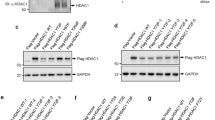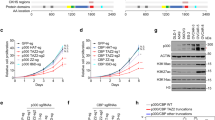Abstract
Post-translational modifications of Notch3 and their functional role with respect to Notch3 overexpression in T-cell leukemia are still poorly understood. We identify here a specific novel property of Notch3 that is acetylated and deacetylated at lysines 1692 and 1731 by p300 and HDAC1, respectively, a balance impaired by HDAC inhibitors (HDACi) that favor hyperacetylation. By using HDACi and a non-acetylatable Notch3 mutant carrying K/R1692−1731 mutations in the intracellular domain, we show that Notch3 acetylation primes ubiquitination and proteasomal-mediated degradation of the protein. As a consequence, Notch3 protein expression and its transcriptional activity are decreased both in vitro and in vivo in Notch3 transgenic (tg) mice, thus impairing downstream signaling upon target genes. Consistently, Notch3-induced T-cell proliferation is inhibited by HDACi, whereas it is enhanced by the non-acetylatable Notch3-K/R1692−1731 mutant. Finally, HDACi-induced Notch3 hyperacetylation prevents in vivo growth of T-cell leukemia/lymphoma in Notch3 tg mice. Together, our findings suggest a novel level of Notch signaling control in which Notch3 acetylation/deacetylation process represents a key regulatory switch, thus representing a suitable druggable target for Notch3-sustained T-cell acute lymphoblastic leukemia therapy.
This is a preview of subscription content, access via your institution
Access options
Subscribe to this journal
Receive 50 print issues and online access
$259.00 per year
only $5.18 per issue
Buy this article
- Purchase on Springer Link
- Instant access to full article PDF
Prices may be subject to local taxes which are calculated during checkout







Similar content being viewed by others
References
Aifantis I, Raetz E, Buonamici S . (2008). Molecular pathogenesis of T-cell leukaemia and lymphoma. Nat Rev Immunol 8: 380–390.
Anastasi E, Campese AF, Bellavia D, Bulotta A, Balestri A, Pascucci M et al. (2003). Expression of activated Notch3 in transgenic mice enhances generation of T regulatory cells and protects against experimental autoimmune diabetes. J Immunol 171: 4504–4511.
Barbarulo A, Grazioli P, Campese AF, Bellavia D, Di Mario G, Pelullo M et al. (2011). Notch3 and canonical NF-{kappa}B signaling pathways cooperatively regulate Foxp3 transcription. J Immunol 186: 6199–6206.
Bellavia D, Campese AF, Alesse E, Vacca A, Felli MP, Balestri A et al. (2000). Constitutive activation of NF-kappaB and T-cell leukemia/lymphoma in Notch3 transgenic mice. EMBO J 19: 3337–3348.
Bellavia D, Campese AF, Checquolo S, Balestri A, Biondi A, Cazzaniga G et al. (2002). Combined expression of pTalpha and Notch3 in T cell leukemia identifies the requirement of preTCR for leukemogenesis. Proc Natl Acad Sci USA 99: 3788–3793.
Bellavia D, Mecarozzi M, Campese AF, Grazioli P, Talora C, Frati L et al. (2007). Notch3 and the Notch3-upregulated RNA-binding protein HuD regulate Ikaros alternative splicing. EMBO J 26: 1670–1680.
Beverly LJ, Felsher DW, Capobianco AJ . (2005). Suppression of p53 by Notch in lymphomagenesis: implications for initiation and regression. Cancer Res 65: 7159–7168.
Bolden JE, Peart MJ, Johnstone RW . (2006). Anticancer activities of histone deacetylase inhibitors. Nat Rev Drug Discov 5: 769–784.
Bots Jr M . (2009). Rational combinations using HDAC inhibitors. Clin Cancer Res 15: 3970–3977.
Buchwald M, Kramer OH, Heinzel T . (2009). HDACi--targets beyond chromatin. Cancer Lett 280: 160–167.
Canettieri G, Di Marcotullio L, Greco A, Coni S, Antonucci L, Infante P et al. (2010). Histone deacetylase and Cullin3-REN(KCTD11) ubiquitin ligase interplay regulates Hedgehog signalling through Gli acetylation. Nat Cell Biol 12: 132–142.
Checquolo S, Palermo R, Cialfi S, Ferrara G, Oliviero C, Talora C et al. (2010). Differential subcellular localization regulates c-Cbl E3 ligase activity upon Notch3 protein in T-cell leukemia. Oncogene 29: 1463–1474.
Clappier E, Collette S, Grardel N, Girard S, Suarez L, Brunie G et al. (2010). NOTCH1 and FBXW7 mutations have a favorable impact on early response to treatment, but not on outcome, in children with T-cell acute lymphoblastic leukemia (T-ALL) treated on EORTC trials 58881 and 58951. Leukemia 24: 2023–2031.
Felli MP, Vacca A, Calce A, Bellavia D, Campese AF, Grillo R et al. (2005). PKC theta mediates pre-TCR signaling and contributes to Notch3-induced T-cell leukemia. Oncogene 24: 992–1000.
Galbiati L, Mendoza-Maldonado R, Gutierrez MI, Giacca M . (2005). Regulation of E2F-1 after DNA damage by p300-mediated acetylation and ubiquitination. Cell Cycle 4: 930–939.
Grozinger CM, Schreiber SL . (2002). Deacetylase enzymes: biological functions and the use of small-molecule inhibitors. Chem Biol 9: 3–16.
Guarani V, Deflorian G, Franco CA, Kruger M, Phng LK, Bentley K et al. (2011). Acetylation-dependent regulation of endothelial Notch signalling by the SIRT1 deacetylase. Nature 473: 234–238.
Hernandez-Hernandez A, Ray P, Litos G, Ciro M, Ottolenghi S, Beug H et al. (2006). Acetylation and MAPK phosphorylation cooperate to regulate the degradation of active GATA-1. EMBO J 25: 3264–3274.
Ianari A, Gallo R, Palma M, Alesse E, Gulino A . (2004). Specific role for p300/CREB-binding protein-associated factor activity in E2F1 stabilization in response to DNA damage. J Biol Chem 279: 30830–30835.
Insinga A, Minucci S, Pelicci PG . (2005a). Mechanisms of selective anticancer action of histone deacetylase inhibitors. Cell Cycle 4: 741–743.
Insinga A, Monestiroli S, Ronzoni S, Gelmetti V, Marchesi F, Viale A et al. (2005b). Inhibitors of histone deacetylases induce tumor-selective apoptosis through activation of the death receptor pathway. Nat Med 11: 71–76.
Kim MY, Ann EJ, Kim JY, Mo JS, Park JH, Kim SY et al. (2007). Tip60 histone acetyltransferase acts as a negative regulator of Notch1 signaling by means of acetylation. Mol Cell Biol 27: 6506–6519.
Lagger G, O'Carroll D, Rembold M, Khier H, Tischler J, Weitzer G et al. (2002). Essential function of histone deacetylase 1 in proliferation control and CDK inhibitor repression. EMBO J 21: 2672–2681.
Leduc C, Claverie P, Eymin B, Col E, Khochbin S, Brambilla E et al. (2006). p14ARF promotes RB accumulation through inhibition of its Tip60-dependent acetylation. Oncogene 25: 4147–4154.
Mateo F, Vidal-Laliena M, Canela N, Busino L, Martinez-Balbas MA, Pagano M et al. (2009). Degradation of cyclin A is regulated by acetylation. Oncogene 28: 2654–2666.
Mercurio C, Minucci S, Pelicci PG . (2010). Histone deacetylases and epigenetic therapies of hematological malignancies. Pharmacol Res 62: 18–34.
Minucci S, Pelicci PG . (2006). Histone deacetylase inhibitors and the promise of epigenetic (and more) treatments for cancer. Nat Rev Cancer 6: 38–51.
Mulligan P, Yang F, Di Stefano L, Ji JY, Ouyang J, Nishikawa JL et al. (2011). A SIRT1-LSD1 corepressor complex regulates notch target gene expression and development. Mol Cell 42: 689–699.
Nebbioso A, Clarke N, Voltz E, Germain E, Ambrosino C, Bontempo P et al. (2005). Tumor-selective action of HDAC inhibitors involves TRAIL induction in acute myeloid leukemia cells. Nat Med 11: 77–84.
Pear WS, Aster JC, Scott ML, Hasserjian RP, Soffer B, Sklar J et al. (1996). Exclusive development of T cell neoplasms in mice transplanted with bone marrow expressing activated Notch alleles. J Exp Med 183: 2283–2291.
Pediconi N, Ianari A, Costanzo A, Belloni L, Gallo R, Cimino L et al. (2003). Differential regulation of E2F1 apoptotic target genes in response to DNA damage. Nat Cell Biol 5: 552–558.
Piekarz RL, Sackett DL, Bates SE . (2007). Histone deacetylase inhibitors and demethylating agents: clinical development of histone deacetylase inhibitors for cancer therapy. Cancer J 13: 30–39.
Puri PL, Sartorelli V, Yang XJ, Hamamori Y, Ogryzko VV, Howard BH et al. (1997). Differential roles of p300 and PCAF acetyltransferases in muscle differentiation. Mol Cell 1: 35–45.
Screpanti I, Bellavia D, Campese AF, Frati L, Gulino A . (2003). Notch, a unifying target in T-cell acute lymphoblastic leukemia? Trends Mol Med 9: 30–35.
Stockhausen MT, Sjolund J, Manetopoulos C, Axelson H . (2005). Effects of the histone deacetylase inhibitor valproic acid on Notch signalling in human neuroblastoma cells. Br J Cancer 92: 751–759.
Talora C, Campese AF, Bellavia D, Pascucci M, Checquolo S, Groppioni M et al. (2003). Pre-TCR-triggered ERK signalling-dependent downregulation of E2A activity in Notch3-induced T-cell lymphoma. EMBO Rep 4: 1067–1072.
Talora C, Cialfi S, Oliviero C, Palermo R, Pascucci M, Frati L et al. (2006). Cross talk among Notch3, pre-TCR, and Tal1 in T-cell development and leukemogenesis. Blood 107: 3313–3320.
Talora C, Sgroi DC, Crum CP, Dotto GP . (2002). Specific down-modulation of Notch1 signaling in cervical cancer cells is required for sustained HPV-E6/E7 expression and late steps of malignant transformation. Genes Dev 16: 2252–2263.
Tsapis M, Lieb M, Manzo F, Shankaranarayanan P, Herbrecht R, Lutz P et al. (2007). HDAC inhibitors induce apoptosis in glucocorticoid-resistant acute lymphatic leukemia cells despite a switch from the extrinsic to the intrinsic death pathway. Int J Biochem Cell Biol 39: 1500–1509.
Vacca A, Felli MP, Palermo R, Di Mario G, Calce A, Di Giovine M et al. (2006). Notch3 and pre-TCR interaction unveils distinct NF-kappaB pathways in T-cell development and leukemia. EMBO J 25: 1000–1008.
Zhang B, Strauss AC, Chu S, Li M, Ho Y, Shiang KD et al. (2010). Effective targeting of quiescent chronic myelogenous leukemia stem cells by histone deacetylase inhibitors in combination with imatinib mesylate. Cancer Cell 17: 427–442.
Acknowledgements
We are grateful to Dr Sonia Coni for experimental support. This work was supported by the Italian Association for Cancer Research (AIRC), the Italian Ministry of University and Research (MIUR), PRIN and FIRB Programs, the Italian Ministry of Health, the European Union (NotchIT ITN Project; FP7-MC-ITN 215761), Eleonora Lorillard Spencer Cenci Foundation and the Fondazione Roma (fellowship to RP).
Author information
Authors and Affiliations
Corresponding authors
Ethics declarations
Competing interests
The authors declare no conflict of interest.
Additional information
Supplementary Information accompanies the paper on the Oncogene website
Supplementary information
Rights and permissions
About this article
Cite this article
Palermo, R., Checquolo, S., Giovenco, A. et al. Acetylation controls Notch3 stability and function in T-cell leukemia. Oncogene 31, 3807–3817 (2012). https://doi.org/10.1038/onc.2011.533
Received:
Revised:
Accepted:
Published:
Issue Date:
DOI: https://doi.org/10.1038/onc.2011.533
Keywords
This article is cited by
-
Epigenetic alterations and advancement of treatment in peripheral T-cell lymphoma
Clinical Epigenetics (2020)
-
Protein Expression Analysis in Uterine Cervical Cancer for Potential Targets in Treatment
Pathology & Oncology Research (2019)
-
Histone deacetylase 6 controls Notch3 trafficking and degradation in T-cell acute lymphoblastic leukemia cells
Oncogene (2018)
-
Prolyl-isomerase Pin1 controls Notch3 protein expression and regulates T-ALL progression
Oncogene (2016)
-
NUMB inhibition of NOTCH signalling as a therapeutic target in prostate cancer
Nature Reviews Urology (2014)



